Expert Consultation Workshop: Shrimp Value Chain in Bangladesh
- From
-
Published on
01.03.23
- Impact Area
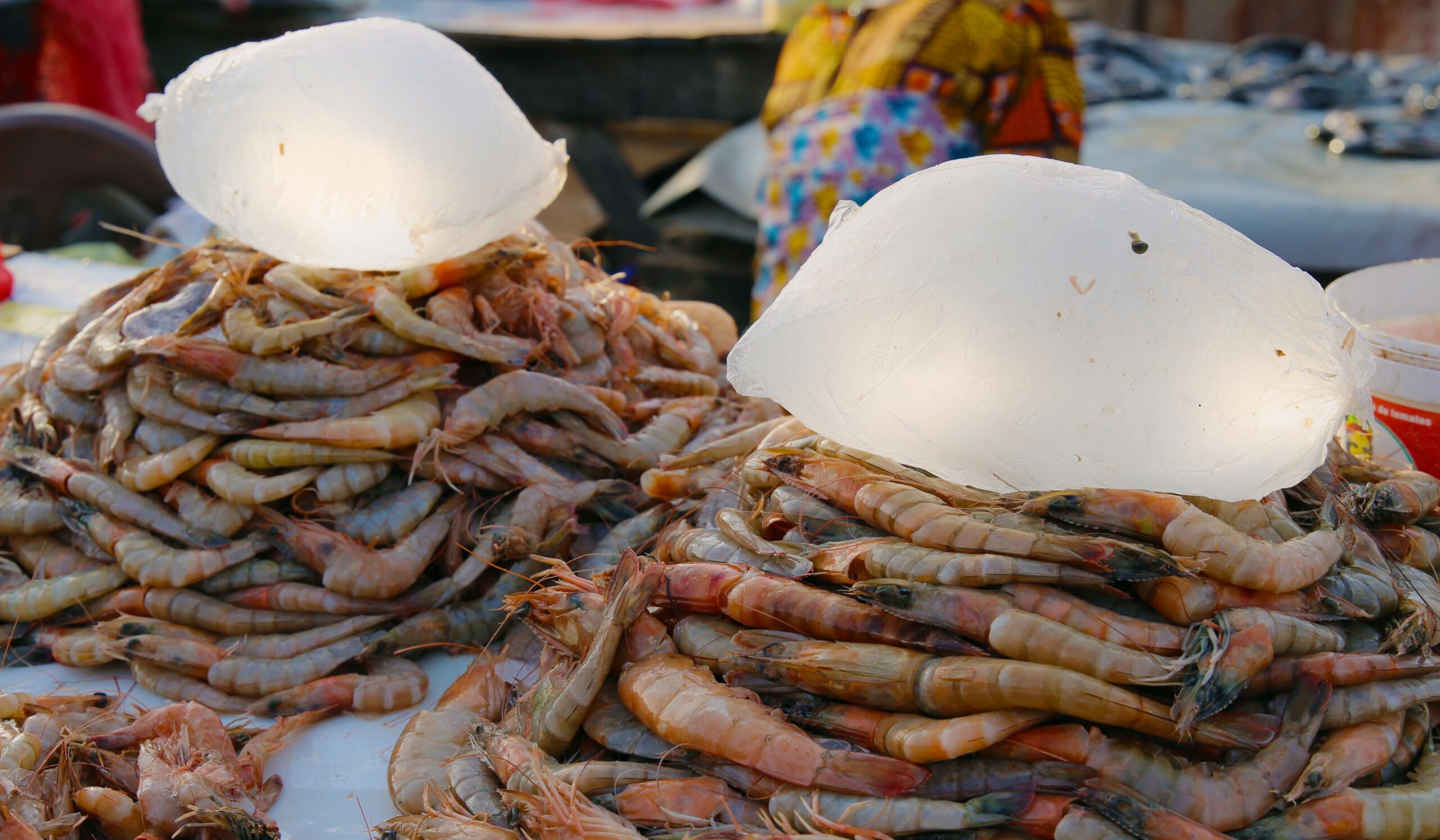
by Razin Iqbal Kabir (IFPRI), Mohammad Mahfujul Haque (BAU), and Sudha Narayanan (IFPRI)
A decade ago, there was much to cheer about Bangladesh’s shrimp export performance. In recent years however, the promise of a shrimp boom has faded, and the sector seems to be at an impasse.
Annual value of exports is still at 1997 levels (around US $0.5 billion). This contrasts with India that started at comparable levels but currently has a market share worth US $8 billion. Shrimp exports have gradually declined since their peak in 2013-14. There is a perception that Bangladeshi shrimp is uncompetitive in global markets; priced higher relative to shrimp from competitors, in part because of lower productivity and in part due to the difference in varieties exported. Whereas Bangladesh’s shrimp sector is dominated by bagda (P. monodon, black tiger), a native species, the global market for shrimp is dominated by white leg shrimp (L. vannamei).
Shrimp exports have fallen in recent years
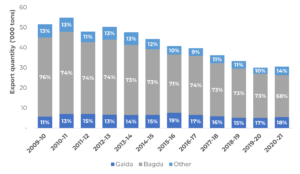
Source: Yearbook of Fisheries Statistics of Bangladesh, several years.
To better understand the problems faced by the shrimp sector, the Work Package 1 team (working on Global Value Chains) of the CGIAR initiative on Rethinking Food Markets conducted a scoping study to document the issues faced by the sector. Feeding into this study was a set of one-on-one interviews with 25 multi-stakeholder experts, led by Dr. Mohammad Mahfujul Haque, Professor, Department of Aquaculture, at Bangladesh Agricultural University (BAU)
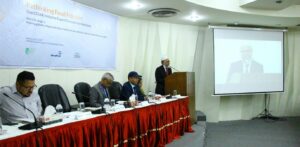
Panelists speaking at the Expert Consultation Workshop
Photo credit: Md. Nazrul Islam, IFPRI
The preliminary results of these interviews were presented at a two-day Expert Consultation Workshop on January 22-23, 2023, at the Centre for Integrated Rural Development in Asia and the Pacific (CIRDAP) in Dhaka. Hosted by the International Food Policy Research Institute (IFPRI), stakeholders across the shrimp value chain, including officials from the Department of Fisheries (DoF) and the Bangladesh Fisheries Research Institute (BFRI), met and shared their views.
Attending on behalf of the Initiative were Dr. Sudha Narayanan (Research Fellow, IFPRI), Dr. Ricardo Hernandez (Agri-food Economist, Alliance Bioversity-CIAT), and Razin Iqbal Kabir (Senior Research Analyst, IFPRI and Country Coordinator for the Initiative in Bangladesh). The objectives of the Consultation Workshop were to: (1) understand the present state of the shrimp sector; (2) identify the scale of critical problems and the difficulty of solving them based on the rankings provided by the 25 experts we interviewed; and (3) gauge prospects for the sector’s growth. The discussions were moderated by Dr. Mohammad Mahfujul Haque. The second day involved a press conference where a panel fielded questions from journalists on the Workshop’s outcomes and the state of the sector.
Structural problems persist
Preliminary findings from the ongoing stakeholder interviews noted that despite some improvements in yields and farmer adoption of modern technical practices, including farm and feed management, significant structural problems continue to plague the sector. “Big, difficult to solve” problems include the lack of crop insurance and formal credit support for farmers, poorly planned water infrastructure, and high feed prices, among others. Other “big, but relatively easier to solve” problems include the limited availability of Specific Pathogen-Free Post-Larvae (SPF PL), poor access to farm-level testing facilities, and unsustainable harvesting of wild PL.
Ranking the problems for the shrimp sector in Bangladesh
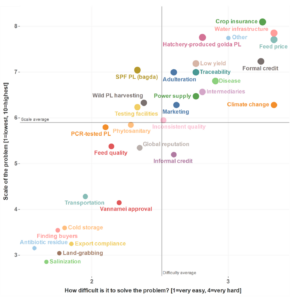
Source: Authors’ calculations using data from expert consultations.
Based on the expert interviews, the bulk of the challenges is at the production end. Small farm ponds and rearing shrimp in ghers constrain the survival of shrimp and productivity of the farms. There is a pressing need for infrastructure, especially for deepening ponds and structures for improving water management. Yet, farmers have little or no financial support, especially from formal institutions, in the absence of collateral.
The sector needs to address technical gaps
There was consensus that shrimp, unlike other species, needs technical knowledge. In the absence of such knowledge and the inputs required to do this (for example, timely availability of appropriate feed), shrimp farming becomes a high-risk venture for small farmers. There is also an associated challenge of ensuring that the farmed shrimp is free from disease. Bangladesh now has at least three hatcheries that produce Specific Pathogen-Free Post-Larvae (SPF PL) that reduces these risks, with another eight in the process of being green-lit for SPF production.
However, the present extensive shrimp farming systems limit the ability of farmers to maintain biosecurity of farms. Recent data suggests that most ponds that grow shrimp in fact also grow substantial quantities of fish. In 2010-11, of the total output from “shrimp farms”, as much as 47% were fish; by 2020-21, the share of fish had grown to 53%. There is also co-culture of multiple shrimp and prawn species at these farms.
Farmers continue to grow fish and other shrimp/prawn species in shrimp farms
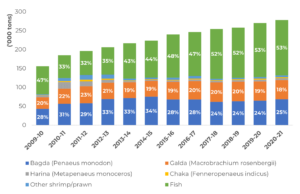
Source: Yearbook of Fisheries Statistics of Bangladesh, several years.
While such farms prevent farmers from specializing and cultivating shrimp intensively, this strategy protects the farmers from the high risks associated with shrimp farming. Farmers, many felt, need to see a demonstration of successful shrimp farm models that will incentivize them and bolster their confidence in shrimp farming in general.
Farm-focused policies and better marketing for bagda shrimp: The way forward
Although vannamei approvals and trials exist, most believe that Bangladesh’s best opportunities remain in bagda, with a focus on market development and branding internationally. Experts also pointed to a growing domestic market for shrimp and prawn, such that exports need not be the only objective. There may also be additional opportunities to target niche markets for shrimp based on sustainable production practices.
Most industry stakeholders felt that there is a need for a holistic policy for shrimp and a dedicated agency committed to developing the shrimp industry. These would enable focused attention on shrimp and enable current efforts of the government and private sector, and identification of specific coastal zones. Some felt that thus far, policies supporting the shrimp sector had been more exporter-centric and that it is time to build a farmer-focused policy that enables farmers to overcome the many constraints they face.
Even while emphasizing the large role for the Government of Bangladesh in shaping and nurturing the shrimp sector, there was agreement that the prospects of the sector lay in the enterprise and innovation of the private sector. There have been several remarkable examples of private sector efforts, be it in developing SPF PL, or experimenting with organic shrimp value chains for export, for instance. Therefore, the sector needs an enabling environment and support at the farm level to alter its current trajectory.
Razin Iqbal Kabir is a Senior Research Analyst at IFPRI office in Dhaka, Mohammad Mahfujul Haque is a Professor in the Department of Aquaculture at Bangladesh Agricultural University, and Sudha Narayanan is a Research Fellow at IFPRI office in Delhi.
Related news
-

Harnessing digital tools in securing soil health for Africa’s food future
Sehlule Muzata27.06.25-
Climate adaptation & mitigation
-
Environmental health
-
Nutrition, health & food security
-
Poverty reduction, livelihoods & jobs
Nairobi, 27 June 2025 (IITA) - As it marks its first anniversary, the Regional Hub…
Read more -
-

Harnessing digital tools in securing soil health for Africa’s food future
Sustainable Farming Science Program27.06.25-
Climate adaptation & mitigation
-
Environmental health
-
Food security
-
Poverty reduction, livelihoods & jobs
Nairobi, 27 June 2025 (IITA) - As it marks its first anniversary, the Regional Hub…
Read more -
-

Beyond tools, toward transformation: ACAT 2025 presses for collaborations
The Alliance of Bioversity International and the International Center for Tropical Agriculture (CIAT)24.06.25-
Climate adaptation & mitigation
-
Environmental health & biodiversity
Over 800 delegates gathered in Kigali Rwanda for ACAT 2025 to explore agri-tech solutions for…
Read more -
